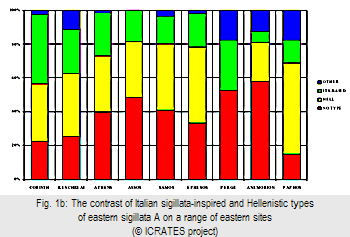

| Forum Archaeologiae - Zeitschrift für klassische Archäologie 35 / VI / 2005 |
Did the consumption of household artefacts reflect and interact with the cultural, political and socio-economic patterning in early imperial Asia Minor? Do we, in other words, have a cause to approach the process of Romanization from things as simple as pottery and glass? Can objects and artefacts have formed part of communication strategies, demonstrating the position of communities, regions or classes?
The early imperial period has previously been defined as the tableware boom period, with new or redesigned lines of sigillata production representing a unique phase of empire-wide cultural integration. In the case of glass wares, the cataclysm that brought glass vessels on every one's table, was, without a doubt the invention of glass blowing. Do such features of integration equal with Romanization in the East, however?
We view Romanization as complex, yet dynamic processes of dialectical exchange. In order to establish the pattern, speed and flow of the dialectical exchange, however, we need to be dealing with issues such as official policy, local communities' responses, regional rivalry, ethnicity, people displaying different loyalties and the working of Roman cultural packages. Therefore, a weaker, more open and creative definition of the concept Romanization is most advisable, best approached by the idea of cultural bricolage, describing 'a process in which new cultural items are obtained by means of attributing new functions to previously existing ones', resulting in 'a complex patchwork made of elements of various age and provenance: some of them are new, but many others are old elements, refunctionalized in new forms and made to serve new purposes within new contexts'.
In this respect, the mixed message of Romanization should be considered:
1. against a much wider chronological framework, illustrated by the role late Hellenistic Delos played in the distribution pattern of early eastern sigillata A, the survival of Sagalassos red slip ware in the third century AD, and the distribution pattern of late Roman African red slip ware as a function of the shifting of gravity of economic activity towards the East.
2. in its proper context, illustrated by the non-Italian sigillata inspired, yet traditional Hellenistic typology of early imperial, mass produced Sagalassos red slip ware (Fig. 1a), or, in general, the differential effect of Italian sigillata on the concept and distribution of the other types of eastern sigillata (Fig. 1b)
3. in its proper social context.


In this respect, any typology of the common types of tableware in the Roman East results from a model of negotiation. On the one hand, there is the elite, who provided the investment in the craft and the socio-cultural matrix of the typologies. On the other hand, in conceiving typologies of household artefacts the elite had to take the mastery of the craftsmen into account, as well as the potential customers. The resulting balance is by nature socially charged, allowing different groups to experience different messages. Considering the historical reality that Rome was a well-structured empire, the attested patterns of socio-cultural influence should come perhaps less as a surprise. The central question is whether all of these manifestations are to be equalled with Romanization. In the sense that it helped identities vis-à-vis the central authorities, it is perhaps useful to talk about Romanization. But most probably the majority of the patterns of socio-cultural influence happened to the people, who were not necessarily aware or even interested in the background of things. The problem is of course, where to draw the line and the fact that drawing only one line, in this case, will surely not be sufficient.
Bibliography: J. Poblome and M. Zelle, The Tableware Boom. A Socio-Economic Perspective van Western Asia Minor, in: C. Berns, H. Van Hesberg, L. Vandeput and M. Waelkens (eds) Patris und Imperium. Kulturelle und politische Identität in den Städten der römischen Provinzen Kleinasiens in der frühen Kaiserzeit, Leuven 2002, 275-287; N. Terrenato, The Romanization of Italy: global acculturation or cultural bricolage?, in: C. Forcey, J. Hawthorne and R. Witcher (eds) TRAC '97. Proceedings of the Seventh Annual Theoretical Roman Archaeology Conference, Oxford 1998, 23; D. Malfitana, J. Poblome and J. Lund, Late Hellenistic imports of eastern sigillata A in Italy. A socio-economic perspective, Babesch 80, 2005, 199-212; J. Poblome, P. Talloen, R. Brulet and M. Waelkens (eds) Early Italian Sigillata. The chronological framework and trade patterns (Babesch Supplement 10) Leuven 2004.